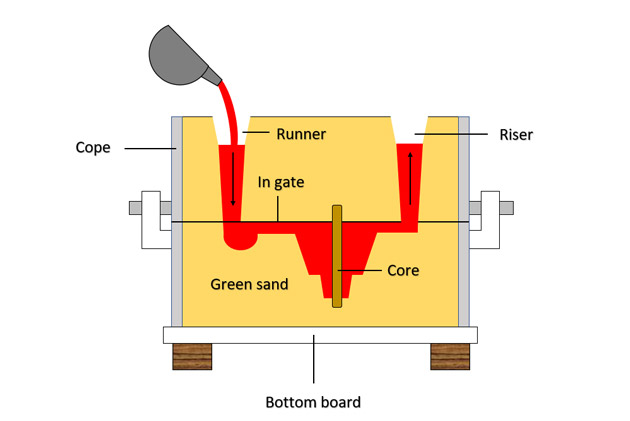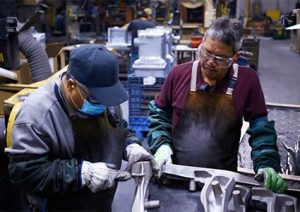The value of Aluminum Foundry Wisconsin in casting projects
Exactly How Aluminum Foundry Adds To Advancements in Aerospace Engineering
Aluminum factories are important to developments in aerospace design. They generate lightweight, high-strength parts that are vital for contemporary airplane. Through innovative casting methods, these shops produce complicated geometries that enhance architectural integrity. In addition, the advancement of premium Aluminum alloys supports the sector's concentrate on gas performance and sustainability. Challenges stay in the manufacturing procedure. Recognizing these elements discloses the extensive impact of Aluminum on aviation's future.
The Significance of Lightweight Products in Aerospace Layout
As the aerospace industry continues to advance, the relevance of lightweight products becomes progressively obvious. The need for efficiency and sustainability drives designers to prioritize making use of materials that lower general weight without jeopardizing architectural honesty. Light-weight products, especially Aluminum, play a vital function in boosting fuel effectiveness, enhancing haul ability, and raising the total performance of aircraft.
In addition, the combination of these products enables innovative designs, allowing suppliers to produce more aerodynamic shapes that can endure extreme problems. The reduction in weight not just lowers operational prices yet also adds to a lowered environmental impact, lining up with international initiatives towards sustainability in aeronautics.
Advanced Spreading Techniques in Aluminum Foundries
Advanced casting techniques in Aluminum shops play a crucial duty in aerospace design by allowing the production of lightweight and specific elements. Innovations in mold and mildew style and accuracy casting procedures are vital in attaining excellent performance and structural integrity. Additionally, the advancement of lightweight alloys enhances the total effectiveness and effectiveness of aerospace applications.
Ingenious Mold Style
Cutting-edge mold and mildew design plays a necessary role in the performance and efficiency of Aluminum foundries, specifically within the aerospace field. By leveraging advanced products and strategies, modern molds can be crafted to withstand heats and pressures, guaranteeing peak efficiency throughout the casting procedure. These layouts often integrate complicated geometries that permit for the manufacturing of light-weight yet structurally audio parts, important for aerospace applications. Additionally, using computer-aided layout (CAD) software application assists in specific modeling, enabling foundries to refine and imitate mold and mildew layouts before physical manufacturing starts. This not just improves the top quality of cast parts but additionally lowers waste and preparation, leading to significant cost savings. In general, innovative mold style is a cornerstone of progress in Aluminum Foundry modern technology for aerospace design.
Precision Casting Processes
The efficiency of cutting-edge mold and mildew designs effortlessly incorporates with accuracy casting processes, which are crucial for generating high-quality Aluminum components in aerospace engineering. These processes, consisting of sand spreading, pass away spreading, and financial investment spreading, ensure the production of intricate geometries with tight resistances. Advanced techniques like vacuum cleaner spreading and stress pass away casting boost the honesty and surface area finish of the end products. Accuracy spreading lessens product waste while maximizing the mechanical residential properties of Aluminum, crucial for aerospace applications. Additionally, using real-time tracking and advanced simulation devices throughout the spreading procedure enables prompt modifications, resulting in boosted quality assurance. Collectively, these accuracy casting processes setting Aluminum factories at the leading edge of aerospace technology, sustaining the sector's demand for integrity and performance.
Lightweight Alloy Development
As aerospace engineers seek to boost fuel performance and performance, light-weight alloy growth becomes a vital focus in Aluminum shops. These shops employ sophisticated casting techniques to develop alloys that supply remarkable strength-to-weight proportions. Technologies in alloy structure, consisting of the consolidation of elements like lithium and magnesium, make it possible for the production of materials that stand up to extreme problems while reducing general airplane weight. Methods such as die spreading and investment spreading assist in the accuracy production of complex forms, which are crucial for aerospace applications. Additionally, recurring study intends to maximize these alloys for improved mechanical homes and increased resilience. By prioritizing light-weight alloy growth, Aluminum shops greatly add to the advancement of aerospace engineering, leading the means for a lot more reliable and lasting airplane styles.

Enhancing Architectural Stability Via Aluminum Elements
Aluminum components supply significant benefits in improving architectural stability within aerospace design. Their light-weight nature adds to overall efficiency while keeping toughness, which is crucial for aircraft efficiency. Additionally, the tension resistance homes of Aluminum help guarantee the sturdiness and reliability of aerospace structures under numerous functional conditions.
Light-weight Material Advantages
While standard materials often jeopardize weight for stamina, using Aluminum components in aerospace design provides substantial advantages in structural integrity. Aluminum's lightweight nature contributes to total style performance, enabling more streamlined airplane that consume less fuel, thus boosting sustainability. The material's excellent strength-to-weight proportion guarantees that parts keep toughness without adding unneeded mass. This high quality cultivates improved performance and dexterity in flight, along with optimized haul capabilities. In addition, Aluminum's resistance to corrosion lengthens the life expectancy of aerospace frameworks, minimizing maintenance prices and enhancing safety. As makers increasingly embrace Aluminum alloys, the aerospace sector experiences a transformative shift towards extra effective and effective design solutions that prioritize both efficiency and ecological duty.
Stress Resistance Properties
Although numerous materials possess special homes, Aluminum's exceptional tension resistance sticks out as a critical variable in enhancing the architectural stability of aerospace parts. This resistance plays a critical role in ensuring that airplane can withstand various operational tensions, including fatigue, effect, and environmental conditions. Aluminum alloys, especially engineered for aerospace applications, show high tensile stamina while preserving light-weight attributes, allowing engineers to design more reliable structures - Aluminum Foundry. Additionally, the capacity of Aluminum to withstand cyclic loading without significant contortion contributes to the long life and reliability of aerospace components. As advancements proceed in Aluminum Foundry methods, the development of stress-resistant Aluminum components promises more enhancements in performance, safety and security, and efficiency throughout the aerospace market, strengthening Aluminum's function as a preferred material in modern-day engineering
Gas Efficiency Improvements Driven by Aluminum Innovations
As the aerospace sector seeks to improve fuel performance, innovative usages of Aluminum have become an important service. Aluminum's light-weight nature especially decreases airplane weight, allowing for reduced gas usage during trip. This reduction in weight is vital, as also small decreases can bring about substantial improvements in general gas economic climate.
Advanced Aluminum alloys, designed for boosted stamina and longevity, allow manufacturers to produce parts that maintain architectural honesty while reducing mass - Aluminum Foundry. Furthermore, the integration of Aluminum in airframes and engine elements promotes improved aerodynamics, adding to reduced drag and boosted efficiency
The adoption of Aluminum in aerospace not only satisfies the need for fuel-efficient layout however additionally aligns with regulative pressures for lower discharges. As these technologies remain to develop, they play a considerable duty in establishing new criteria for gas efficiency, guaranteeing that the aerospace industry can satisfy expanding financial and ecological obstacles.

The Role of Aluminum in Sustainable Aeronautics Practices
The boosting emphasis on lasting air travel methods has placed Aluminum as an important material in the quest for greener pop over to these guys airplane layout. Recognized for its lightweight residential properties, Aluminum significantly reduces airplane weight, causing lower gas intake and discharges. Its recyclability further enhances its sustainability account, as Aluminum can go to website be recycled forever without loss of quality. This characteristic supports a round economic climate within the aviation market, reducing waste and resource exhaustion.
Developments in Aluminum alloys have actually improved their toughness and corrosion resistance, allowing for longer service life and reduced upkeep needs. These technologies assist in the development of a lot more efficient aircraft frameworks, contributing to total sustainability efforts. In addition, Aluminum's thermal conductivity plays a vital role in energy-efficient designs, improving systems such as warm exchangers. Collectively, these qualities underscore Aluminum's critical role in progressing lasting air travel, straightening with global efforts focused on decreasing the ecological impact of flight.
Obstacles Faced by Aluminum Foundries in Aerospace Production
While Aluminum shops play a vital duty in aerospace manufacturing, they deal with substantial difficulties that can affect manufacturing performance and quality. One major difficulty is the rigorous quality control requirements needed in the aerospace sector. Any type of issue can endanger safety and performance, requiring extensive assessment procedures that prolong production timelines. Furthermore, factories commonly emulate fluctuating basic material prices, which can influence rates and success. The complexity of Aluminum alloys utilized in aerospace applications more complicates the manufacturing procedure, as exact solutions are crucial for accomplishing desired mechanical residential or commercial properties. Additionally, experienced labor shortages impede the ability to preserve top notch production levels. Finally, environmental policies impose constraints on exhausts and waste administration, requiring foundries to invest in lasting methods, which can be cost-prohibitive. These variables jointly produce a landscape where Aluminum shops need to constantly adjust to fulfill the evolving demands of aerospace manufacturing while making sure security and conformity.
Future Patterns in Aluminum Applications for Aerospace Design
With improvements in technology and boosting needs for performance, the future of Aluminum applications in aerospace engineering is poised for significant makeover. The assimilation of ingenious Aluminum alloys and compounds is expected to boost strength-to-weight proportions, bring about more fuel-efficient airplane designs. In addition, improvements in additive manufacturing methods will permit the manufacturing anonymous of complicated Aluminum structures that were previously difficult, maximizing efficiency and lowering waste.

Lasting techniques will certainly play a vital function, with an expanding focus on recycling Aluminum to lessen ecological effect. The aerospace sector is likely to embrace smarter making procedures, such as automation and fabricated intelligence, making sure better and precision in Aluminum parts. Collaborations between Aluminum foundries and aerospace business will certainly foster study and growth, leading the method for brand-new applications that meet the strict needs of modern aerospace design. On the whole, the future looks promising for Aluminum's role in shaping the skies
Often Asked Questions
What Are the Environmental Effects of Aluminum Production in Aerospace?
The ecological effects of Aluminum production in aerospace include significant power consumption, greenhouse gas exhausts, and environment disruption. In addition, mining procedures can cause dirt destruction and water contamination, elevating problems concerning sustainability and ecological balance.
Exactly How Does Aluminum Contrast to Other Materials in Aerospace Applications?
Aluminum provides a special combination of lightweight residential properties, rust resistance, and cost-effectiveness compared to other materials. Its high strength-to-weight ratio makes it especially advantageous for aerospace applications, enhancing fuel effectiveness and total performance in airplane design.
What Credentials Do Aluminum Foundry Employees Need for Aerospace Projects?
Aluminum Foundry employees require specific training in metallurgy and spreading strategies, along with understanding of aerospace market criteria. Certifications in top quality control and safety protocols are additionally vital to guarantee compliance with stringent aerospace project demands.
Are There Any Kind Of Security Interest In Utilizing Aluminum in Aerospace Design?
Security worries pertaining to Aluminum in aerospace engineering include sensitivity to stress, fatigue, and corrosion fractures. Appropriate therapy and alloy selection are necessary to minimize these threats, making certain structural honesty and total safety and security in aerospace applications.
Exactly How Does Aluminum Recycling Advantage the Aerospace Sector?
Aluminum reusing greatly profits the aerospace industry by reducing product prices, decreasing ecological effect, and preserving energy. This lasting practice boosts the sector's effectiveness while promoting using lightweight, high-performance elements in aircraft manufacturing.
Advanced spreading methods in Aluminum foundries play a critical duty in aerospace engineering by enabling the manufacturing of exact and light-weight elements. Cutting-edge mold design plays an important function in the effectiveness and performance of Aluminum foundries, specifically within the aerospace market. As aerospace designers seek to improve gas efficiency and efficiency, lightweight alloy growth becomes an important focus in Aluminum foundries. Aluminum alloys, specifically engineered for aerospace applications, exhibit high tensile toughness while keeping lightweight characteristics, making it possible for engineers to develop a lot more effective frameworks. Partnerships in between Aluminum foundries and aerospace business will cultivate study and advancement, paving the way for new applications that meet the strict requirements of modern aerospace engineering.